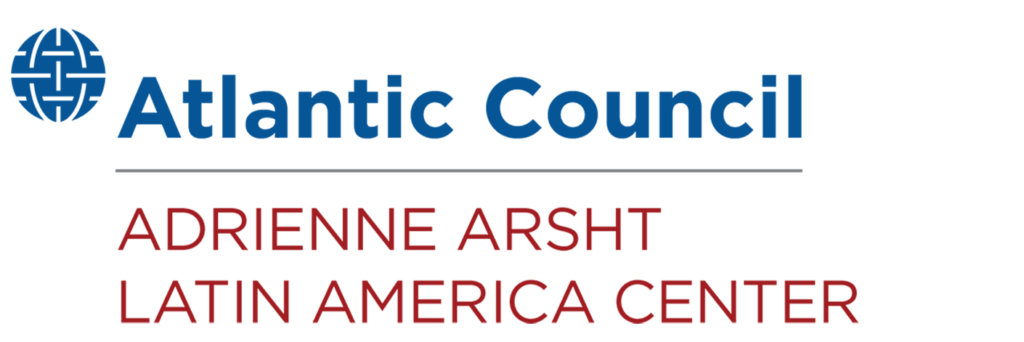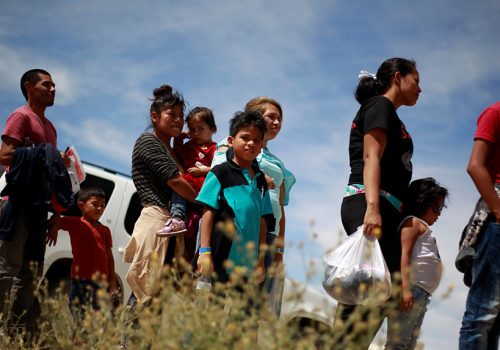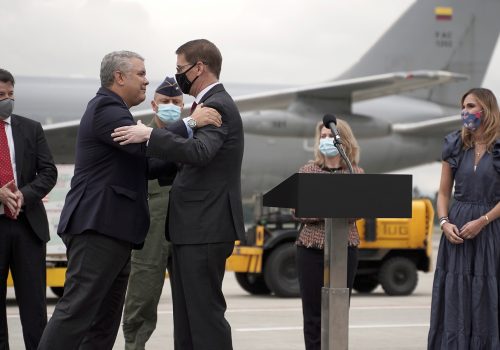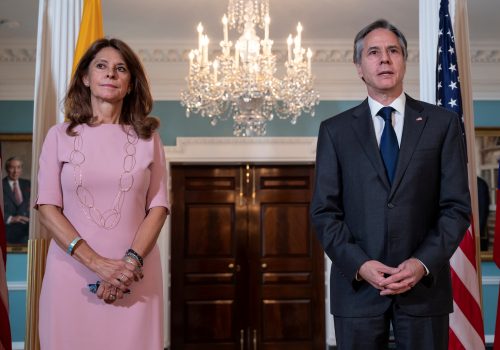Support a holistic migration strategy
Colombia hosts one of the largest displaced populations in the world, roughly 1.8 million Venezuelans, who have fled their country due to political conflict, economic turmoil, and the partial breakdown of the healthcare system.1Only Turkey (and perhaps soon Poland) hosts a larger displaced population. Regarding Venezuelan displacement, see Andrew Selee and Jessica Bolter, “Colombia’s Open Door Policy: An Innovative Approach to Displacement,” International Migration, No. 60 (2022): 113-131, https://onlinelibrary. wiley.com/doi/epdf/10.1111/imig.12839. Updated figures on the number of Venezuelans in Colombia (and other countries), compiled by the UN High Commissioner for Refugees and the International Organization for Migration, can be found at www.r4v.info. Most of these displaced migrants arrived after 2017, when the underlying push factors accelerated. Another half-mil- lion Colombians living in Venezuela have returned simultaneously. More than two million Venezuelans have crossed through Colombia in transit to other countries, with Haitian, African, and Asian migrants increasingly moving through Colombia toward the United States. Their arrival has turned Colombia, once a country with few immigrants but many nationals living abroad, into an immigrant society.
Two elements have been particularly innovative in Colombia’s response to Venezuelan displacement. First, the country offered temporary, long- term legal status to Venezuelans arriving in the country before January 31, 2021. This decision was a first-of-its-kind move in Latin America and pro- vides a long-term path to permanent residence for a population increasingly likely to stay. In contrast to many countries receiving large-scale dis- placed peoples, Colombia has chosen to integrate Venezuelan migrants into the local labor market, education system, and national life instead of relying on the international community to shelter, feed, and care for those arriving.
Second, this approach has been an all-of-government effort directed by the presidency rather than a single agency or set of agencies. In many other cases, governments have implemented short-term legalization programs, but often with contradictory signals from different parts of government on whether the migrants are welcome.2Andrew Selee and Jessica Bolter, An Uneven Welcome: Latin American and Caribbean Responses to Venezuelan and Nicaraguan Migration (Washington, DC: Migration Policy Institute, February 2020). There have been similar whole-of-government approaches from Argentina and Uruguay and, to a lesser extent, Brazil, but the numbers of arrivals compared to the overall population are a fraction of Colombia’s. The signals have been mixed across different government agencies in other countries receiving large numbers of displaced Venezuelan migrants, including Chile, Ecuador, Panama, Peru, and Trinidad and Tobago. The Colombian government has made it clear that it is the official government policy to receive, recognize, and integrate all Venezuelans who arrive. Most local governments have also engaged in this effort, and all political parties have sought to avoid politicizing the question of Venezuelan immigration, even if some individual politicians haven’t always toed the line.
The Colombian response represents an act of solidarity with people from a neighboring country, and a strong element of pragmatism, given Colombia’s real limitations to restrict irregular entries from Venezuela and the need to know who is entering and staying in Colombia. There is a realization that the arrival of so many Venezuelans will eventually produce economic benefits. At the same time, actual adjustment costs need to be paid upfront, including emergency services, implementing regularization campaigns, and, most importantly, expanding education, healthcare, and other services to deal with a rapidly growing population. The international community has helped defray some of these costs, but others are being borne by Colombian taxpayers in the short term.
Colombia’s emergency response evolves
Initially, no one could have imagined the number of Venezuelans who would eventually cross Colombia’s border. At first, in 2017, the Colombian government issued a temporary two-year stay permit, the Permiso Especial de Permanencia (Special Stay Permit or PEP), to Venezuelans who entered the country legally through official ports of entry. Other regularization programs followed for those who had entered without registering, and by November 2020, Colombia had regularized the status of 707,000 of the 1.72 million Venezuelans in the country.3Selee and Bolter, “Colombia’s Open Door Policy,” 119-120. However, the measures never fully kept up with the demand, and the requirement to renew the PEP every two years created bureaucratic backlogs.
Finally, the government decided in February 2021 to conduct an even more ambitious effort by offering a ten-year stay permit to all Venezuelans who were already in the country, regardless of their legal status. The new permit, the Permiso de Protección Temporal (Temporary Protection Permit or PPT), sought to cover all Venezuelans who had entered the country by January 31, 2021, and would be available during the next year for those who entered Colombia legally from Venezuela. The PPT permit allows access to services and employment and creates a pathway for recipients to transition to permanent residence with time already spent in the country counting toward the five-year residency requirement.4Natalia Banulescu-Bogdan and Diego Chaves-González, “What Comes Next Now that Colombia Has Taken a Historic Step on Migration,” Migration Policy Institute, February 2021, https://www.migrationpolicy.org/news/colombia-historic-legalization-what-next.
The Colombian government also offered a TarjetadeMovilidadFronteriza (Border Mobility Card or TMF) to Venezuelans living in the border region, allowing them to cross the border freely. This mechanism was introduced to dissuade migrants from moving to the country’s center by providing a border permit to allow access to emergency health services, education, and work.5Although the government discontinued using this permit in 2020 due to the COVID-19 pandemic, this measure issued 5.2 million TMFs to Venezuelan nationals. Still, it is hard to determine how many of these holders remain in Venezuela, how many regularized their status under the PEP or PPT schemes, or how many transited to other countries. Selee and Bolter, “Colombia’s Open Door Policy.”
Also, all children born in Colombia of Venezuelan parents are citizens, even though Colombia’s constitution usually does not allow this unless the parents are legally domiciled in the country. The Colombian government got around this limitation by enacting a presidential decree, Primero la Niñez(Children First), noting its obligations under the International Convention on Statelessness of 1961.6This decree allowed the National Registry of Civil Status to grant Colombian nationality to all children who had a Venezuelan parent and were born in Colombia as of August 19, 2015. This measure later evolved into a law expanding its validity for two more years.
Since 2019, it has been made clear that all Venezuelans are eligible to enroll in primary, secondary, and tertiary education.7Government of Colombia, “Welcome, Integrate and Grow, Colombia,” 2020: 92. Before 2019, one of the main challenges of integrating students into the education system was the documentation barrier. Migrants without legal status could not access or move through the different levels of education. The government established detailed instructions for Colombian educational establishments to overcome this obstacle. For Venezuelan students without a valid passport or foreign identity card—a requirement needed for taking the state exams or validating their high school diploma—the government passed a resolution that allowed them to do so. Emergency medical assistance is also open to all, regardless of immigration status. However, Colombia’s healthcare system is not universal, making the incorporation of recent migrants into the healthcare system more complex; many are not yet affiliated.8There are two different healthcare regimes: subsidized and contributory, which have consistently remained restricted for migrants. Data from Colombia on access to public health insurance is limited, but official numbers from 2021 found that 60 percent of Venezuelan migrants did not have health insurance, and three out of four with health insurance were taking part in the subsidized regime since many migrants are not part of the formal economy, which would allow them to access the more robust contributory healthcare regime.
Despite these efforts to incorporate Venezuelan migrants through legal documentation and access to education and basic healthcare, according to a 2021 study, 97 percent of Venezuelan nationals in Colombia worked in the informal economy, compared to only 48 percent of Colombian citizens.9Diego Chaves-González, Jordi Amaral, and María Jesús Mora, Socio economic Integration of Venezuelan Migrants and Refugees: The Cases of Brazil, Chile, Colombia, Ecuador,and Peru (Washington, DC: Migration Policy Institute, July 2021), https://www.migrationpolicy.org/research/socioeconomic-integration-venezuelan-migrants-refugees. A key obstacle to accessing the formal labor market has been credential recognition. Many Venezuelans arrive in Colombia with strong qualifications and professional experience but find it difficult to get their educational and professional credentials recognized, limiting their job opportunities while depriving Colombia of essential skills. Streamlining the credential recognition process would help Venezuelan migrants and the Colombian economy, which needs doctors, dentists, engineers, and teachers.
Colombia’s migration decision on the global stage
The other essential ingredient needed to continue deepening the integration process for Venezuelan migrants is public buy-in. Colombian political and social leaders have consistently tried to include average citizens in their efforts to welcome Venezuelans, but this is challenging in a society already divided along ideological, regional, and ethnic lines. September 2020 polling shows that more than one-third of Colombians believe facilitating migrant integration benefits Colombia more broadly, but most Colombians are less certain.10Proyecto Migración Venezuela, “Diferencias regionales en la percepción de los Colombianos hacia los migrantes,” Fall 2021: 5, https://s3.amazonaws.com/semanaruralvzla/documentos/1609184052_boletin_16_de_percepcion_regionalpdf.
Changing this perception is critical for getting the necessary public sup- port to integrate migrants and ensure that current efforts survive changes in government at a national and local level. Doing so will be even more challenging during pandemic recovery since people often feel they are competing over scarce resources and jobs and have had fewer opportunities to forge social connections during intermittent lockdowns. To achieve ambitious policy reform, the public must believe its best interests are being served and that there is a sense of common purpose between migrants and host communities.
This necessitates investing in basic public services, ensuring that schools, hospitals, and housing stock expand in cities hosting large numbers of Venezuelan migrants so migrants and native-born Colombians benefit equally. Some pushback against new arrivals has nothing to do with the migration itself but with the precarious nature of public services that were already overtaxed before Venezuelans arrived en masse.11Selee and Bolter, An Uneven Welcome.
But ensuring a mutual sense of purpose between Colombians and Venezuelans also requires building new narratives about Colombian society that emphasize why and how Colombia has responded by receiving and integrating Venezuelans and how they share a common future.12Natalia Banulescu-Bogdan, Haim Malka, and Shelly Culbertson, How We Talk about Migration: The Link between Migration Narratives, Policy, and Power (Washington, DC: Migration Policy Institute, Rand Corporation, National Immigration Forum, and Metropolitan Group, 2021). The current administration—and many local political and social leaders—have been adamant about finding a future together, but there are also increasing voices of hostility toward the Venezuelans living in Colombia, especially on social media and in local politics.
The international community can play a vital role in supporting Colombia’s efforts to integrate Venezuelan migrants in tangible and intangible ways. Among the most crucial international endeavors have been concessional loans from the World Bank and Inter-American Development Bank, which have supported infrastructure development, healthcare access, and housing in parts of the country with significant immigration. However, moving from concessional loans to preferential interest rates and other mea- sures to support Colombia as a recipient of the hemisphere’s largest refugee and migration crisis would be a smart next step.
The Regional Platform for Venezuelan Refugees and Migrants, led by the UN High Commissioner for Refugees and the International Organization for Migration, which supports a regional response to the displacement crisis, has been a vital source of support for a range of initiatives from improving education access to combating xenophobia. And behind all these initiatives, the US government has been a particularly important partner, channeling funding and political support into these undertakings.
The US and Colombian governments have also worked closely on a broader regional strategy to promote safe, orderly, and regular migration across the hemisphere. The October 2021 ministerial summit hosted by Colombian Foreign Minister Marta Lucía Ramírez and US Secretary of State Antony J. Blinken in Bogotá was a critical step toward building a broader shared understanding of migration across the hemisphere, as was the April 2022 ministerial in Panama that followed. The main points of those two meetings—how to integrate migrant populations and create legal pathways that generate order in future migration movements—speak directly to Colombia’s current challenges.
The key question is how to ensure that Colombia’s commitment to integrating a large displaced population leads to positive gains for the country overall, not only in its international reputation and bilateral relationships but also in the everyday lives of Colombians. It is critical for the policy of the last two administrations to remain state policy as administrations change. This will require the ongoing commitment of the Colombian government and strong and consistent support from the international community. As a result, Colombia’s solidarity with displaced Venezuelans will also depend, at least in part, on the solidarity of other countries around the world. Here, no country could play a bigger role than the United States. Using its lever- age within financial institutions and its resources, it could help Colombia expand its education system, healthcare access, and infrastructure to incorporate the arrival of Venezuelan migrants and make sure that host communities benefit in the process.
Related Allies essays
A roadmap for a new type of engagement
This moment opens the door for a reimagined US partnership with Colombia based on a shared vision for a more prosperous, inclusive, and sustainable future.
Related program

The Adrienne Arsht Latin America Center broadens understanding of regional transformations and delivers constructive, results-oriented solutions to inform how the public and private sectors can advance hemispheric prosperity.
Image: People, permitted for humanitarian reasons, cross the Simon Bolivar International bridge from Cucuta, Colombia, after it was reopened, as seen from in San Antonio del Tachira, Venezuela October 4, 2021. REUTERS/Carlos Eduardo Ramirez



